► Your guide to Polestar’s EVs
► ‘Polestar Day’ reveals brand’s future plans
► Extreme fast charging, autonomous tech and more details on new volume EVs
Polestar is a name that’ll be familiar to some electric car converts – but alien to the majority of motorists. It’s the new spin-off brand from Volvo, designed to spearhead the Swedes’ move into electrification with a dose of progressive style more akin to Tesla than Toyota.
It’s safe to say that the brand has found its footing. In 2022, Polestar sold around 51,500 cars – an 80 per cent increase on the previous year. In 2023, the brand has already set its goal to sell more than 80,000 cars.
And now the brand’s further aping its California-based competition, with a ‘Polestar Day’ event during which it revealed several impressive plans for the future.
‘Extreme Fast Charging’ for Polestar 5
Showing off a production-spec version of the new Polestar 5 four-door, CEO Thomas Ingenlath announced plans for a new battery pack from firm StoreDot, capable of so-called ‘Extreme Fast Charging’.
With battery sizes for premium EVs swelling in the bid for greater range comes a corresponding increase in charging times, so faster juice-boosting is on the mind of many brands. Polestar says StoreDot’s latest pouch cell design can be charged with 100 miles of range in just five minutes.

The tech, dubbed XFC for short, can be integrated into existing battery designs and uses silicone anodes to deliver the boost in charging speeds. StoreDot says XFC will not degrade the battery any more than existing rapid charging. Expect to see prototypes of the Polestar 5 equipped with this tech in 2024, though production might take a while after that.
Polestar 4 and the Mobileye Chauffeur
Working with Luminar and Mobileye, Polestar aims to have a full hands-off and eyes-off autonomous driving system available in the Polestar 4. Dubbed the Mobileye Chauffeur, it uses LiDAR and a surround camera-based SuperVision system to provide level 3 autonomy.
This means point-to-point automous driving on motorways and in other controlled environments with human intervention required only in emergencies, as well as hands-off driving in more regular use – albeit with the human driver still keeping a close watch.
We’ll keep an open and slightly cynical mind about this one – nobody’s yet managed to get eyes-off autonomous driving to work outside of very specific scenarios.
The Polestar 3 ‘Virtual Power Plant’
Vehicle-to-Grid or V2G is a big deal in the EV world, utilising bi-directional charging to allow cars to not only take power from the grid but to give it back, either to an individual home or to the grid at large. Many utopian visions of the future see a large electric vehicle parc working seamlessly with country’s national electricity grids, cushioning the impact at peak times and helping with the somewhat choppy power delivery of many renewable energy sources.
Polestar’s going great guns with this approach, with a large-scale project in Gothenberg, Sweden powered by a fleet of Polestar 3 cars. The so-called ‘Virtual Power Plant’ will link all participating vehicles, calculating the collective capacity of the connected batteries and charging or discharging them based on grid demand.
Owners will be able to ‘both contribute to the energy transition and monetise their EV while it’s parked’. The smart charging tech aims to optimise battery use for the owner’s transport needs – for example, if your car knows you drive to work every morning at 8, it’ll avoid letting the grid discharge your battery for the morning rush at 7.
Polestar CEO Ingenlath said: “Vehicle-to-grid has the potential to not only benefit individual customers, but whole comunities. The average car is parked 90% of the time. With the bi-directional charging capabilities of Polestar 3 and the Polestar VPP, we can explore business models and community solutions that can unlock the true potential of V2G and enable owners to support the energy transition when they don’t need their car for driving.”
All about Polestar
Polestar was conceived under the watch of former CEO Hakan Sameulsson, and engineered to be a more modern, trendy, tech-led business than Volvo. While Volvo is gradually transitioning to all-electric powertrains, Polestar is entirely battery-powered today. It’s so achingly on-trend and focused on sustainability, Polestar even offers vegan interiors.
Boss Thomas Ingenlath, former lead designer at Volvo and now the CEO of Polestar Cars, elaborates: ‘Volvo is clearly defined by its comfort, safety and practicality. Polestar is not bound by this. Polestars will be designed more around the individual, and be more progressive and performance-oriented.’
Ingenlath wants to offer more ‘complete performance electric cars’ than any current offering. ‘Electric cars now are defined by their acceleration. That’s useless in day-to-day driving, and sometimes they’re so fast they can be frightening. We will make cars that are really enjoyable to drive in handling, steering and in overall everyday performance.’
Quick, sustainable and dripping with premium style… Here’s how the Polestar range is shaping up in 2023.
Polestar 1: the original pathfinder (and a plug-in hybrid)

The Polestar 1 was the very first car and a statement of intent for Geely’s premium electrified brand. It’s gone off sale now and you’ll only find a few secondhand examples available. A hybrid two-door coupe, the Polestar 1 bore the biggest resemblance to a Volvo of the models released so far; aside from the grille, the 1 looked a lot like a slightly shortened S90 saloon. That’s because it was based on the Volvo Concept Coupe of 2013.
It uses a version of the SPA platform familiar from the XC90 et al and a modified 592bhp, Volvo T8 plug-in hybrid powertrain to boost performance and electric-only range. 62mph arrives from a standstill in just 4.2 seconds, and there’s an all-electric range of 93 miles. In addition, features such as adjustable Öhlins shocks hint at Polestar’s tuning-firm beginnings (its origins are as Volvo’s motorsport division).
Inside, the Polestar borrowed heavily from the Volvo range, too, using a variant of the brand’s Sensus touchscreen software. The Polestar 1 wasn’t cheap when it was on sale: it cost £139,000 in the UK.
Read our review of the Polestar 1 here
Polestar 2: the all-electric Tesla Model 3 fighter
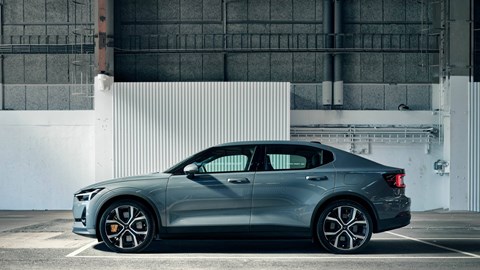
The Polestar 2 is the first bespoke EV from the Swedish EV brand and on sale now. The Tesla Model 3 rival wears a tweaked version of Volvo’s Concept 40.2 design and is based on its sister brand’s CMA platform, so it’s not as roomy as some EVs.
It is quick though: twin-motor versions pack an all-wheel-drive, 402bhp EV powertrain capable of 0-62mph in 4.7 and a range of up to 335 miles. Lower-powered, single-motor models are also now available, priced from £43,150 in the UK.
Inside, the Polestar 2 surrenders its infotainment system to Google; the 2 uses the search giant’s new HMI software, essentially a more powerful, baked-in version of Android Auto. Like all Polestars, it’s Swedish engineered and Chinese manufactured, on a dedicated site next to Volvo’s existing factory in Chengdu.
Read our review of the Polestar 2 here
What’s next for Polestar? The EVs coming soon
A raft of additional models is under development, as Polestar has floated on the New York stock exchange to raise the funds required for expansion.
The solitary model on sale today will soon be joined, predictably enough, by a flurry of Polestars from 3-5 (and beyond). Expect a new EV to join the range every year until mid-decade.
Polestar 3: an all-electric answer to the Porsche Cayenne/Tesla Model X
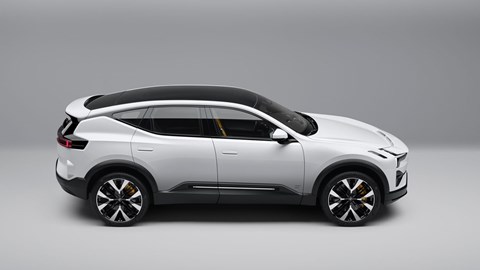
Next up is the Polestar 3, an all-electric ‘aerodynamic’ SUV which has been teased with the revealing photograph above ahead of its full debut in October 2022. It’s taller and more crossover-like than the Polestar 2 – keeping in line with the first premium EV pioneers such as the Audi e-Tron and Jaguar i-Pace.
The Polestar 3 is likely to be the most popular EV in the range, with increased practicality over the 2 and especially 1. CEO Ingenlath has described it to CAR as being a direct rival for the Porsche Cayenne.
Expect a price around £65,000, reflecting its premium hardware dubbed SPA2, the electric-ready architecture that’ll also underpin the new XC90.
Read more about the Polestar 3 here
Polestar 4: a lower-slung electric SUV – target Macan
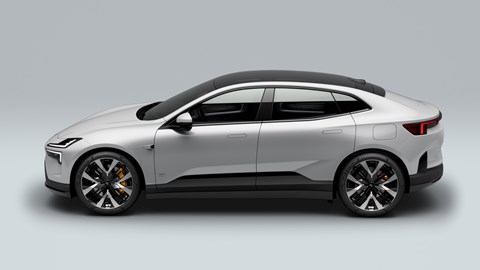
Polestar has also quietly announced some new details of its new 4, another ‘aero SUV.’ The new Polestar 4 will be a coupe SUV and will join the range ranks in 2023.
‘We have a second SUV in our pipeline,’ Ingenlath revealed. ‘It will compete below the Polestar 3’s €75,000 [£65k] sector, it is slightly smaller. It will not compromise on the interior length, but this car is slightly more ground-hugging, a bit more of the coupe-type roofline.’
Think Porsche Macan to the Polestar 3’s Porsche Cayenne market positioning. CAR understands it’ll be based on the hardware of a Geely platform and we expect prices around €55,000 (£45,000).
Read more about the Polestar 4 here
Polestar 5: Precept – low-volume, aluminium-intensive GT
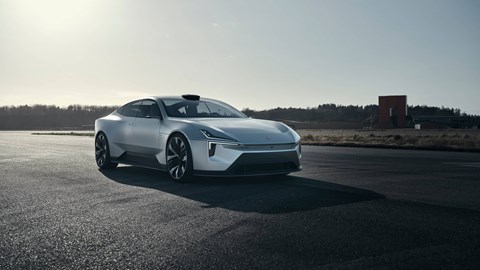
The Polestar 5 hasn’t been officially revealed yet in production guise, but the recent Precept concept is our first look at the Polestar 5 due in 2024. The largest departure from Volvo’s styling yet, the 5 will build on the themes of the first two cars but go bigger and bolder.
The Polestar 5 takes the shape of a four-door GT, which places the Porsche Taycan and Audi e-Tron GT firmly in its crosshairs. ‘Precept is a declaration, a vision of what Polestar stands for and what makes the brand relevant,’ said Ingenlath of the concept which inspires the 5. ‘The car is a response to the clear challenges our society and industry face.’
Underpinning the Polestar GTs will be a new bonded aluminium architecture developed at the brand’s British engineering base in Coventry, where it benefits from the expertise learned by ex-Lotus, Aston Martin and McLaren engineers.
Read more about the Polestar 5 here
Polestar 6: the world’s first convertible EV
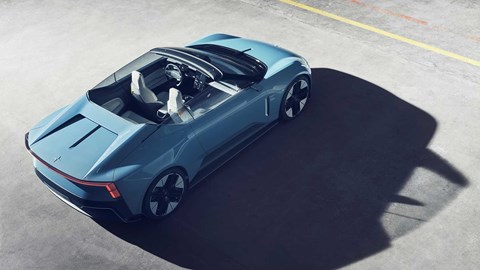
Ever wondered why there are no convertible electric cars? Wonder no more. Polestar confirmed in summer 2022 that it would put the Polestar 6 into production from 2026 – it’s the open-top version of the 5, a low-volume, high-cost two-seater roadster.
Its electric powertrain should mean that passengers connect with Mother Nature more easily with the roof down and the Swedes promise rapid performance too, thanks to twin motors developing a combined 650kW output (equivalent to 872bhp and 664lb ft) powered by an 800-volt electrical architecture.
Flies in the ointment? The Polestar 6 will cost around £170,000 at launch… this aluminium-intensive sports car won’t be cheap…
Read more about the Polestar 6 here
Polestar batteries and fast-charging tech
Polestar has teamed up with tech pioneer StoreDot, as it looks to increase its electric battery know-how. StoreDot is currently a class-leader in fast-charging technology, and the new partnership will see Polestar investigate the use of its silicon dominant, lithium-ion cells.
The Geely offshoot isn’t the first to the party though; it joins a client list including Daimler, BP and Samsung, as brands look to improve charging time as well as range.
And it’s fast, very fast. StoreDot’s ‘100in5’ technology is already on track for providing 100 miles of range with 5 minutes charging by 2024 – and is currently being tested by leading OEMs.
‘Charging and range anxiety are common concerns holding owners of combustion engine cars back from making the switch to EVs,’ said Polestar CEO Ingenlath. ‘StoreDot’s advanced battery technology potentially provides real solutions to these obstacles. If our current pilot projects with StoreDot are successful, we could see these solutions being implemented in Polestar cars by 2026.’
Sustainability: a carbon-neutral car by 2030
Key to the Polestar mission is a new plan to create a climate neutral car by 2030. Called Polestar 0, the goal was announced at the company’s first annual review in 2021, and aims to put some world-saving figures behind the brand’s already green marketing and production practices.

Interestingly, Polestar isn’t be pursuing a policy of offsetting (planting trees to replace CO2 produced during manufacturing cars) as the Swedish car brand questions the practice’s long-term viability. A statement released by Polestar suggests ‘a forest might be logged, devastated by fire or altered by climate change,’ therefore ending any benefits.
‘We’re electric, so we don’t have to worry about combustion engines producing toxic emissions – but that doesn’t mean our job is done. We will now work to eradicate all emissions stemming from production,’ said Polestar’s head of sustainability, Fredrika Klarén.
Polestar already integrates climate targets into its employee bonus scheme, but now it’s taking a more visible approach: carbon footprint credentials are published in Polestar Spaces and online for all future models – starting with the 2 – in the same way you can find out how many calories are contained in a Big Mac.
Whether people will take a similar approach to Polestar’s transparency, as they do to McDonalds’, remains to be seen. And to save you a Google search, it’s 508 calories, consisting of 25g of fat, 43g of carbohydrates and 26g of protein.